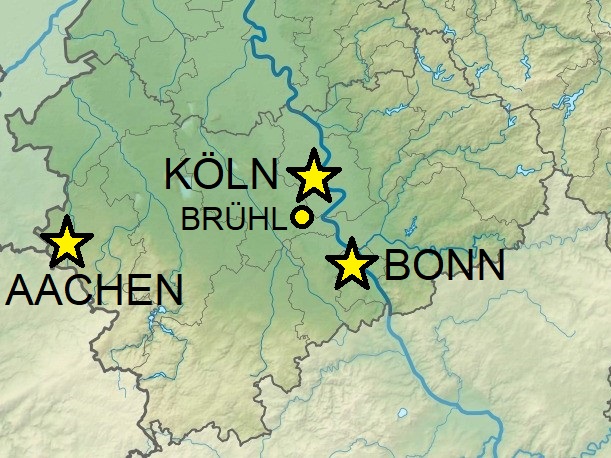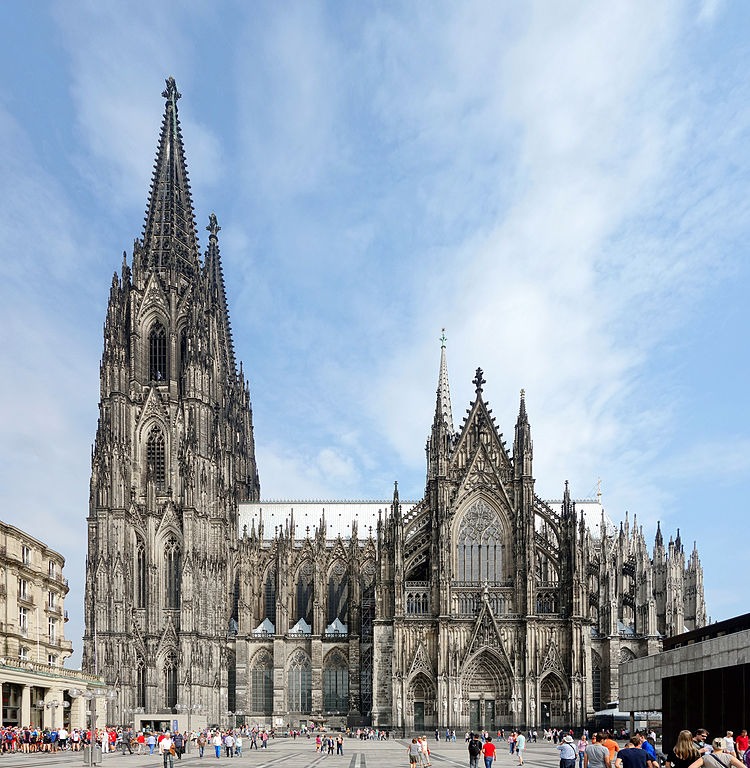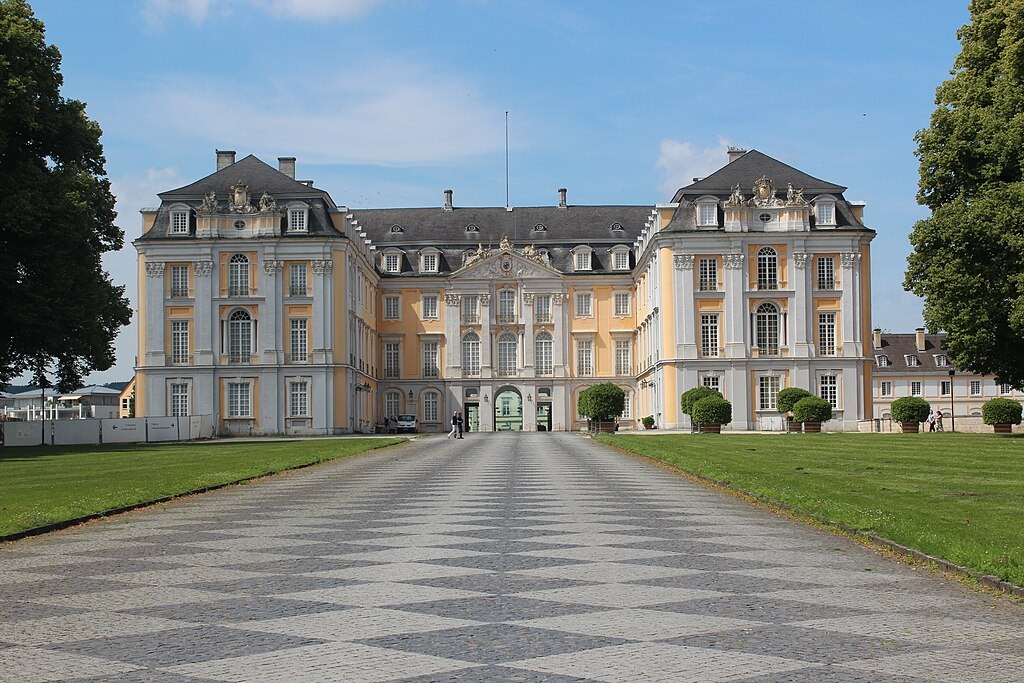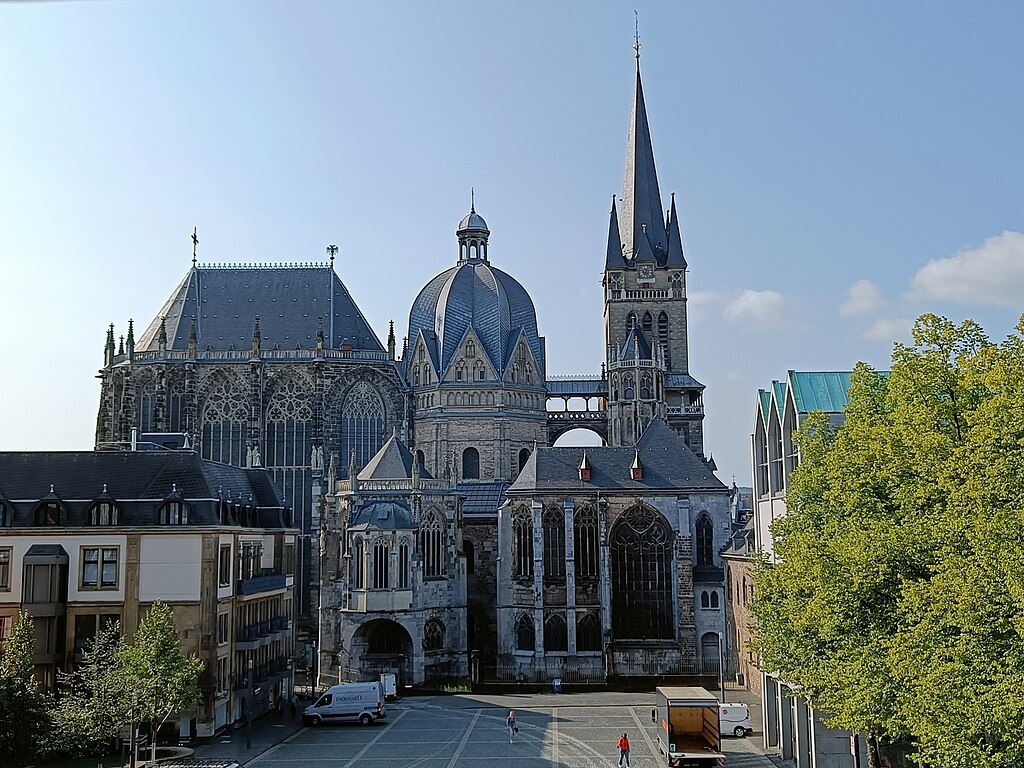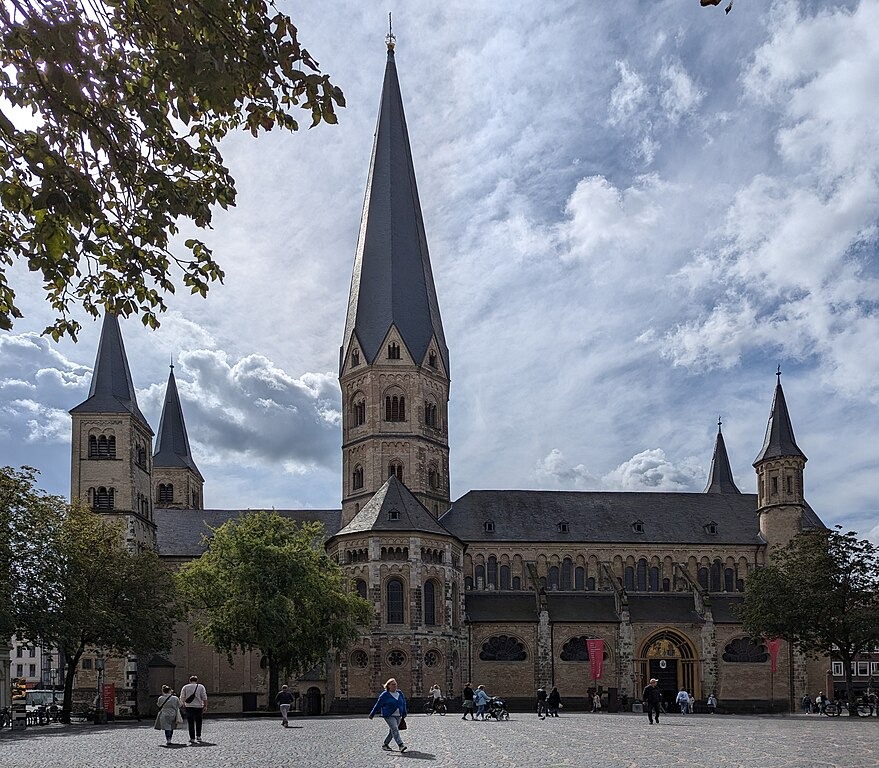The area along the west bank of the Rhine river in the North Rhine-Westphalia state of Germany houses several large cities and historic sites. Among these is Cologne, the largest city in the region and one of the major cultural centers in the country. When visiting Cologne, it’s easy to take a day trip to other nearby cities, most notably Aachen and Bonn, both of which have a long and rich history.
Position of Cologne (Köln), Aachen, Bonn, and Brühl.
Cologne
We start our trip in Cologne, which can be easily reached by train, bus, and car from any other major city in the area. There’s also an airport located between Cologne and Bonn, with flights connecting it to most destinations in Europe. The nearby airports in Frankfurt and Düsseldorf also have intercontinental flights, and are connected to Cologne by train.
Founded by the Romans, the city flourished as one of the major trading centers along the Rhine for centuries, and was one of the largest cities in Europe during the Middle Ages and the Renaissance. The city is famous not only for its historic attractions and museums, but also as an important cultural center with several scientific institutions, and for the perfume known as Eau de Cologne.
Just outside the main train station of Cologne is its most famous attraction, the huge cathedral, which is one of the most notable examples of Gothic architecture. Construction of this church began in the 13th century and was only completed in the 19th century. With a height of 157 meters, the Cologne Cathedral is also the third tallest church in the world, and was briefly the tallest structure in the world between 1880 and 1884. Now, it is a UNESCO World Heritage site and the most visited landmark in Germany. Inside the cathedral are several notable artworks, with the most famous being the Shrine of the Three Kings, a medieval reliquary which is said to house the relics of the Biblical Magi. It’s also possible to climb the over 500 steps of the south tower of the church, and an amazing view over Cologne can be enjoyed from the top.
View of the Cologne Cathedral from the south (Velvet, Wikimedia Commons, CC BY-SA 4.0).
Just behind the cathedral is the Museum Ludwig, which houses a collection of modern art, with works by artists such as Andy Warhol and Roy Lichtenstein. Nearby is the historic Hohenzollern Bridge, which crosses the Rhine and it’s flanked by four equestrian statues of Prussian kings. The bridge is also famous for the custom of putting love padlocks on it, which now number in the hundreds of thousands. Back on the west side of the Rhine, the old town of Cologne houses twelve historic Romanesque churches, with some being worth a visit. Among these are the Basilica of St. Cunibert, known for its medieval glass windows, the Basilica of St. Ursula, which houses a chamber adorned with thousands of bones, and the Basilica of St. Gereon, famous for its peculiar structure which includes a decagonal oval dome. These three churches are all located in the area north and north-west of the cathedral.
South of the cathedral is instead Alter Markt, the main square of the old town, which also houses the historic town hall of the city. Nearby is the most famous of the Romanesque churches of Cologne, the Great St. Martin Church, which is best known for its tall decorated tower. Not far from the cathedral on the southern side are also a few interesting museums, such as the Museum of Applied Art and Kolumba, a museum of religious art. Near Alter Markt is also the Wallraf–Richartz Museum, a large art museum with Gothic, Renaissance, Baroque, and Impressionist artworks.
Continuing to the south from Alter Markt, visitors can cross the large square called Heumarkt and take a stroll along the Rhine, reaching the Rheinauhafen, a historic port along the river. Here, on the tip of the peninsula along the river, is the Chocolate Museum. This museum shows the entire history of chocolate and how it’s produced today, and is one of the most visited museums in Germany.
From here, visitors can walk a bit to the west to reach the start of the Hohe Straße, a long shopping street which features numerous stores and boutiques and extends all the way to the cathedral. Another popular shopping street is Schildergasse, which begins from Hohe Straße and goes west towards another large square, known as Neumarkt. Next to Neumarkt is the Belgian House, which currently houses the collection of the Romano-Germanic Museum, which is undergoing restoration works. Nearby is also the Rautenstrauch-Joest Museum, a museum of ethnography mostly centered on Amerindian and Polynesian cultures.
Cologne houses several other attractions and museums located further from the city center, such as the Museum of East Asian Art, which houses numerous artworks from China, Korea, and Japan. Various large ancient city gates are also spread along the edges of the old town, including the Eigelstein-Torburg to the north, the Hahnentor to the west, and the Severinstorburg to the south.
Cologne is a large city with several attractions, and probably not all those listed here can be visited in a single day, so visitors can choose which landmarks and museum they prefer to see, or can spread their visit over two days if they have the opportunity. When staying in Cologne for various days, it’s also worth taking a trip to Brühl, a small town located nearby and easily reachable with a quick train ride. Here are the Augustusburg and Falkenlust Palaces, which are a former royal palace and its hunting lodge, and are listed as UNESCO World Heritage sites. A masterpiece of rococo architecture, the Augustusburg Palace features elaborate artworks and decorations. This castle is surrounded by a vast park known as Schlosspark, which is connected to the Falkenlust Palace, located more in the countryside and also richly decorated.
The Augustusburg Palace in Brühl (Wandernder Weltreisender, Wikimedia Commons, CC BY-SA 3.0).
Aachen
Aachen is a city located west of Cologne, near the border with Belgium and the Netherlands, and can be easily reached by train from Cologne in less than a hour. Aachen is best known for its medieval history, as it was the center of power of the empire of Charlemagne. Now an important university city, Aachen features various medieval attractions and museums linked with its rich history.
Near the train station is the medieval city gate known as Marschiertor, while along the edges of the city center is the Elisenbrunnen, a Neoclassical thermal spa built in the 19th century. Some ancient Roman ruins are located in the adjacent park, which is located right next to the most historic part of the city.
The Aachen Cathedral is the main attraction of the city, and dominates over the old town. Originally built as a chapel of the palace of Charlemagne, the church was later greatly expanded with Romanesque and Gothic additions, and for centuries it was the site where German kings were coronated. In 1978, the Aachen Cathedral was one of the first 12 sites to be listed as a UNESCO World Heritage site. Inside, the church is richly decorated with mosaics and artworks, and houses the Marienschrein, a medieval reliquary which houses relics of Jesus, Mary, and Saint John the Baptist. Another reliquary, the Karlsschrein, instead houses the remains of Charlemagne. These, along with the Shrine of the Three Kings in Cologne, make up a trio of reliquaries which are considered to be masterpieces of the Mosan art of the 12th and 13th century.
More masterpieces can be found in the Aachen Cathedral Treasury, a museum of religious art located next to the cathedral. Among the most famous artworks in this museum are the Bust of Charlemagne, dating from the 14th century, and the richly adorned Cross of Lothair, a jewelled cross made around the year 1000. On the north side of the cathedral is Katschhof, the main square of the old town. Facing this square is the Centre Charlemagne, a museum of local history. Closing the square to the north is the historic Aachen Town Hall, a large Gothic building erected in the 14th century. The building can be visited and houses exhibitions on local history. The Aachen Town Hall also divides Katschhof from another large square simply known as Markt. This central area of the city is surrounded by some shopping streets, such as Krämerstraße just next to Katschhof, Großkölnstraße to the north-east, and Adalbertstraße to the east. Further to the north, at the edge of the old town is the Ponttor, a massive medieval city gate.
View of the Aachen Cathedral from the Aachen Town Hall (Karmakolle, Wikimedia Commons, CC BY-SA 4.0).
Bonn
Bonn is located just south of Cologne, along the Rhine river, and can be reached with a quick train ride. Originally founded by the Romans, Bonn became the capital of the Electorate of Cologne between 1597 and 1794, serving as the seat of the local archibishops and electors. Bonn rose to prominence once again after World War II, and was the capital of West Germany from 1949 to 1990. Bonn still retains its political importance today, but it is also a university city and houses various historic attractions. The city is also known for being the birthplace of Ludwig van Beethoven.
The main church of the city, the large Bonn Minster, is located not far from the train station. A masterpiece of Romanesque architecture, it was built between the 11th and 13th century. While the interior is decorated with various artworks, the most famous attraction here are the two large sculptures depicting the heads of the legendary Cassius and Florentius. The large square next to the church, known as Münsterplatz, instead houses a monument dedicated to Beethoven.
Just east of the Bonn Minster is instead the vast Electoral Palace, once the residence of the local rulers, and now seat of the University of Bonn. Continuing along the road in front of this palace, visitors can reach another large square, which hosts the richly adorned ancient town hall of Bonn, which dates from the 18th century. A bit north of this square is the Beethoven House, a museum dedicated to the famous composer and hosted in the house where he was born. If you’re visiting Bonn between March and April, it’s also worth to take a stroll along the tree-lined streets on the north side of the old town, which have an abundance of flowering cherry blossoms during spring.
Various other interesting museums can instead be found outside the old town, such as the Bonn Museum of Academic Art, which hosts a collection of plaster casts of ancient sculptures. South of the old town are the Museum Koenig Bonn, a rich museum of natural history, and the Haus der Geschichte, a museum dedicated to the history of West Germany during the Cold War. Nearby are also the Kunstmuseum Bonn, a museum of modern art, and the Kunst- und Ausstellungshalle der Bundesrepublik Deutschland, which hosts exhibitions related to art and culture. The Bonn Egyptian Museum is instead currently closed for renovations.
View of the Bonn Minster from Münsterplatz (Gerd Eichmann, Wikimedia Commons, CC BY 4.0).


